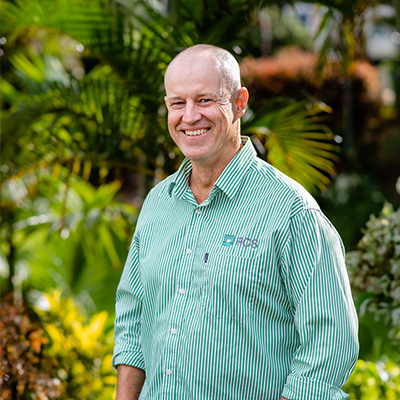
Dennis Donohoe, farm manager with Aminya Pastoral, is a seasoned producer with decades of experience, and his story is a testament to how even minor changes in farming practices can lead to significant improvements in productivity and land health.
Do you have a Grazing Chart? If so, are you using it to your advantage? In this article, Andrew Zerner—an RCS Next Steps Coach, Advisor and Facilitator—uses his experience as a grass farmer and beef cattle producer in QLD to discuss the importance of Grazing Charts.
For this article, I wanted to share my thought processes with grazing over the summer and discuss ‘where to from here’ for my steer trading operation near Murgon in southeast Queensland. Bottom line up front, I follow the RCS Grazing Principles. But not because I’m biased. Rather, it’s because I want to be brilliant at the basics.
Our season break came two months early, arriving with good rain in the first half of October. From mid-October, I went straight to a 60-day rest period for our first lap around, calculating the length of my graze periods using the RCS Graze Period Calculator (provided to anyone who attends a Farming & GrazingforProfit program or Grazing Clinic) and the paddock rating method.
I was planning to weigh, draft and sell as soon as my daughter got home from boarding school in late November. Since I had matched the stocking rate to carrying capacity during the non-growing season, I still had a reserve of dry grass in October. I replaced this sale mob before I sold to utilise this grass and take advantage of the existing market conditions.
An odd light fall of rain stopped and started the grass growing over that initial 60 days. The next significant rainfall was in mid-December. I again used the Graze Period Calculator, working on a 45-day rest period. I noted in the margin of my Grazing Chart last summer that a 35-day rest period was too short for my legumes, reminding myself to extend it to 45 days next season.
“All this planning and monitoring is worthless unless I act on my discoveries.”
Things were going well through Christmas and New Year. By mid-January, the grass was starting to slow up, so I strategically added an extra day or two to certain paddocks to extend my rest period. I did another weigh and drafted cattle for sale at the end of January before my daughter returned to school. The cattle looked good and had an average daily gain that I was quite happy with.
There was still no rain by this point, so I put my rest period out to 60 days. Within a week, I decided that this was still too short, so I extended my rest to 90 days using the Graze Period Calculator again. This handled the second grazing principle, though it must be continually monitored, ground-truthed in the paddock and adjusted as needed.
With no rain in January, my Grazing Chart showed that the stocking rate shot up above my benchmark carrying capacity. Looking forward, even if I get average rainfall, I have a big total to take off my rolling rainfall at the end of the month, pushing my SDH/100mm even higher. To follow the third principle, I need to reduce my number of LSUs significantly.
Knowing the number of cattle and LSUs that I would generally run—or had planned to run through the non-growing season—I’ve worked out the amount of feed I need to accumulate in SDHs. Comparing what I have in the paddock now and what I still need to accumulate, I’ve adjusted my sales plan to sell and not replace over the next six months to match the stocking rate to carrying capacity. I’ve also tweaked my budgets accordingly. If we get significant rain in the next six weeks, the plan is still to sell and not replace, as it takes a long time to bring the stocking rate in SDH/100mm back to the benchmark carrying capacity.
All this planning and monitoring is worthless unless I act on my discoveries. If I don’t, I will be in a world of hurt through the next nine months until my Green Day. This is why Plan, Monitor and Manage is the first principle.
I may not be able to control rainfall, but I can control the condition of my paddocks so that they respond quickly to any rain that does fall. In the fourth RCS Regenerative Grazing Principle, there are other things I can do to maintain control:
Overall, I keep going back to the RCS Grazing Principles. I have confidence in them like I have confidence in the experience of the many professional grazing managers in the RCS network who continually develop, refine, challenge and prove them. Together we hold decades of experience and care for millions of hectares across the country and overseas, running hundreds of thousands of head of livestock. By continuing to follow the RCS Grazing Principles, we will continue to produce food and fibre forever.
If you want to clarify or improve your grazing management, or it’s been a while since you explored the RCS Grazing Principles, it’s worth booking in to do a course. No matter how often I do them or sit in for sections, I still come home with a list of improvement points for my land.
Check here for upcoming GrazingforProfit® and Farming & GrazingforProfit programs or Grazing Clinics in your area. Enjoy what you do, and be brilliant at the basics.
Cheers,
Andrew
Andrew Zerner is a grass farmer and beef cattle producer from Murgon, QLD. Andrew enjoys sharing his knowledge and learning from others in his role as a Teacher, Advisor, Facilitator and Coach.
Author:

Teacher, Advisor, Facilitator and Coach
Profitable Paddocks is our educational newsletter sent to your email inbox every quarter.
Click the Bell for the latest blogs.

Dennis Donohoe, farm manager with Aminya Pastoral, is a seasoned producer with decades of experience, and his story is a testament to how even minor changes in farming practices can lead to significant improvements in productivity and land health.
Once you have ownership as to why planning is important, the next ingredient is to work out where and how you will do your planning. When you write something down you change your relationship with the content. I cannot emphasise enough the power of getting your thoughts and plans out of your head onto paper or the computer.
The season in SA and Tassie is particularly tight right now with little or no useful rain since early January and a generally failed 2023 spring prior to that. Right now, across southern Australia and much of the eastern NSW, you won’t need to drive far out into the countryside to see cattle and sheep grazing (and lying on) hay and silage trails lined across paddocks.
Martha Lindstad and partner Robert James are farm managers on ‘Karalee’, Enngonia NSW. Both have travelled different paths to being where they are. Martha is originally from Norway, growing up on a three hectare farm before travelling to New Zealand and eventually the Pilbara in Western Australia. It was here that she saw the benefits of sustainable farming for the country and livestock.
The Prince’s RCS mentor, Raymond Stacey, sees a strong future ahead for Simon and Laura. “The Drought Resilient Soils and Landscapes project is about supporting graziers to manage their country and businesses better,” Raymond said. “I see an operation here where they’re working hard on their planning and putting their plans into action to leave their country, business and people in better shape.”

Join our mailing list
